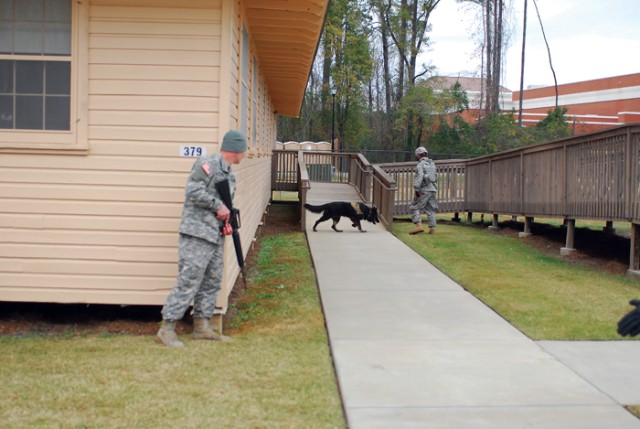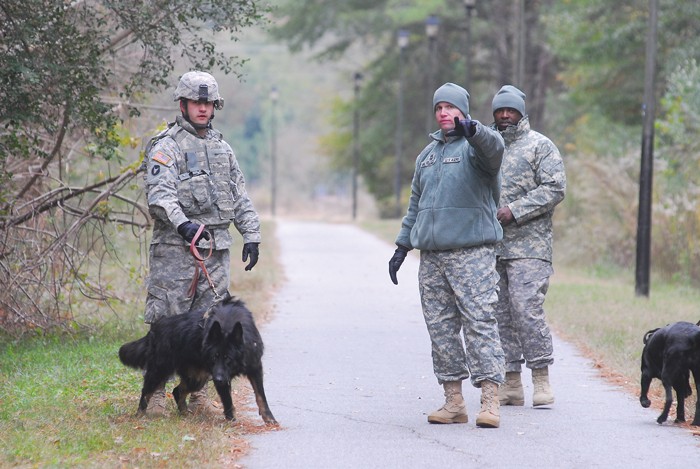FORT BENNING, Ga. (Dec. 10, 2010) - "Bomb" and "drug" dogs have been scouring Fort Benning this week, sniffing out explosives and illegal narcotics in barracks rooms and buildings. But it's not what you think. These dogs are military working dogs undergoing annual certification. And the drugs and explosives' They're training aids - planted by members of the 209th Military Police Detachment's military working dogs section - with just enough authenticity for the dogs to sniff them out.
Several military working dog teams from posts across the Army underwent Department of the Army-level testing this week, a requirement to ensure the quality of each team. Each team, made up of a handler and a canine, is evaluated in detection and patrol skills over a four-to five-day period.
"This certification ensures the quality of the teams being pushed out to missions and deployments - that the teams are capable of detecting what they are trained to," said Sgt. 1st Class Tyshawn Anthony, Fort Benning's kennel master.
Master Sgt. Jason Hathaway, TRADOC's Military Working Dog Program manager, conducts the certification for Training and Doctrine Command units. He evaluates teams based on a set of criteria. Explosive detection dogs must detect at least 95 percent of the training aids in each scenario. Narcotic detection dogs must locate at least 90 percent of drug training aids. Each dog must then get a "go" in patrol techniques, which include locating hidden suspects and assisting in apprehension.
"If they're not certified, they can't do anything else. Can't work the law enforcement role here, can't deploy," Hathaway said.
To put to rest any questions of whether the dogs can detect narcotic or explosive substances, the training aids are not fake.
"A fake or pseudo drug or explosive doesn't have all the characteristics of the real deal. I don't want there to be any doubt in my mind that if someone plants C-4 and our dog gets sent out on the mission, he will be able to detect it," said Anthony, who notes two of Fort Benning's 17 teams are currently deployed.
Some of the explosives the dogs are trained to detect include TNT, C-4, smokeless powder, ammonium nitrate, dynamite and water gel. Narcotics dogs can detect marijuana, cocaine, methamphetamines and heroin among other drugs.
Staff Sgt. John Thomas has been a handler for five years and deployed to both Iraq and Afghanistan. Thomas' current companion is Max, a 2-year-old Belgian malinois trained in explosive detection.
Thomas said each dog has different reactions during detection, but each usually sits once they've finally located the spot. The dogs are trained not to attempt to uncover the training aid because in a real situation they could potentially detonate the explosive.
"It takes you pretty much the first time to realize 'OK, that's what he's going to do when he finds a bomb.' But there are different little nuances before he actually finds it to indicate he's caught the scent ... it takes a while to be able to read the dog. I've been working with him for a month and I still don't know every little thing about (his technique) yet. That takes years," said Thomas, who's trained with four other military working dogs in his career.
Thomas said he and his military working dog helped Cavalry scouts with patrols, route clearance and building searches in Iraq.
"(The scouts) definitely view you as a valued asset," Thomas said.
Sgt. Donald Miller, and his dog Maxi, came from Fort Rucker, Ala., for the certification. Miller graduated from the handler's course at Lackland Air Force Base in San Antonio, Texas, in August.
Maxi, a 4-year-old German shepherd, is a narcotic detection dog.
Miller, a member of the 6th Military Police Detachment, said dogs like Maxi are helping to stop the flow of drugs from Iraq and Afghanistan.
"Military working dogs work at the airports, searching bags before they leave the country," he said.
Certification ended Thursday with patrol testing, an important role for both explosive and narcotic detector dogs, the kennel master said. Patrol dogs are trained to be obedient both on and off leash. They are trained to attack at the command of their handler and can be called off at any time.
"If you use a gun and fire off a round, you can't recall that bullet. One of the benefits of having patrol-capable military working dogs, is that you can send them out to catch a suspect and if the suspect gives up before that dog reaches them, you can call that dog back and, in a sense, stop the bullet," Anthony said.
What's the difference between explosive and narcotic dogs'
There are two types of military working dogs: explosive and narcotic detector dogs. Explosive detector dogs can detect odor concentrations as small as one or two parts per billion. Narcotic detector dogs are capable of detecting drugs such as marijuana, cocaine, hash and heroin sealed in plastic bags and glass jars, and packaged with other substances intended to mask the drug's scent, according to officials at the 341st Training Squadron, who run the Military Working Dog course in San Antonio, Texas.
Both types of dogs are used to support combat operations, protect installations and personnel, and support special missions nationwide and overseas. A third type of military working dog, the specialized search dog, was introduced in 2005 in response to the rising threat of improvised explosive device attacks in Iraq and Afghanistan. These dogs are highly skilled counter-terrorist search assets trained to detect arms, ammunition and both conventional and homemade explosives. Fort Benning has one SSD team. They are considered critical assets and have resulted in the detection, confiscation and destruction of hundreds of thousands of pounds of weapons, ordnance, explosives and ammunition, 341st TRS officials said.






Social Sharing